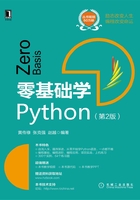
上QQ阅读APP看书,第一时间看更新
2.5.3 逻辑运算符和逻辑表达式
逻辑表达式是用逻辑运算符和变量连接起来的式子。任何语言的逻辑运算符都只有3种——逻辑与、逻辑或和逻辑非。C、Java语言的逻辑运算符用 & & 、||、!表示,Python采用and、or、not表示。表2-4列出了Python中的逻辑运算符和表达式。
表2-4 Python中的逻辑运算符和表达式

下面的代码演示了逻辑表达式的运算。
01 # 逻辑运算符 02 print( not True) 03 print( False and True) 04 print (True and False) 05 print (True or False)
【代码说明】
·第2行代码,True的逻辑非为False。输出结果:False
·第3行代码,检测到and运算符左侧的False,就直接返回False。输出结果:False
·第4行代码,检测到and运算符左侧为True,然后继续检测右侧,右侧的值为False,于是返回False。输出结果:False
·第5行代码,or运算符的左侧为True,于是返回True。输出结果:True
逻辑非的优先级大于逻辑与和逻辑或的优先级,而逻辑与和逻辑或的优先级相等。逻辑运算符的优先级低于关系运算符,必须先计算关系运算符,然后再计算逻辑运算符。下面这段代码演示了逻辑运算符、关系运算符和算术运算符的优先级别。
01 # 逻辑表达式的优先级别
02 print( "not 1 and 0 =>", not 1 and 0)
03 print( "not (1 and 0) =>", not (1 and 0))
04 print ("(1 <= 2) and False or True =>", (1 <= 2) and False or True)
05 print ("(1 <= 2) or 1 > 1 + 2 =>", 1 <= 2, "or", 1 > 2, "=>", (1 <= 2) or (1 < 2))
【代码说明】
·第2行代码,先执行not 1,再执行and运算。输出结果:
not 1 and 0 => False
·第3行代码,先执行括号内的1 and 0,再执行not运算。输出结果:
not (1 and 0) => True
·第4行代码,先执行1<=2的关系运算表达式,再执行and运算,最后执行or运算。输出结果:
(1 <= 2) and False or True => True
·第5行代码,先执行1<=2的关系运算表达式,再执行表达式1>1+2,最后执行or运算。输出结果:
(1 <= 2) or 1 > 1 + 2 => True or False => True